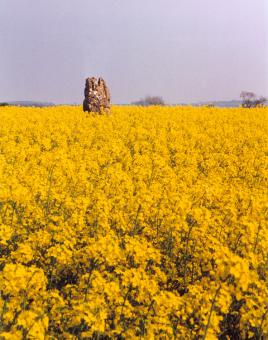 |
![]() Photo � Celia
Haddon
Photo � Celia
Haddon
| OS Map: OL45 The Cotswolds |
amazon.co.uk bookshop.co.uk (up to 20% off) countrybookshop.co.uk (up to 20% off, free UK P&P |
| OS Map ref: SP339235 | |
| Nearest town: Chipping Norton | |
| Nearest village: Chadlington |
|
Free preview of our Stone
Circles CD-ROM in the new Stone Circle Shop |
|
|
Deep in a field of rape seed. This is a suberb standing stone and one which I [PB] think has a lot more occult history known of it than described here. It is first illustrated and named on a local map of the region in 1743 CE, and has fortunately managed to escape the intense agricultural ravages endemic to this part of the country. This impressive weather-worn eight-foot tall standing stone stands aloft in the centre of a field due west of the road between Chalford Green and Dean.
In local folklore and some earlier archaeologists, the Hawk Stone formed an integral part of a stone circle here, but there is little known evidence to substantiate this. In Thorn Graves' (1980) dowsing experiments at the Rollright circle, he found what he described as an 'overground' linking the Circle to the Hawk Stone, but no other connecting sites are known along this line. Interestingly one legend surrounding the monolith tells how this monolith was thrown, or dragged, across the land by a old witch or hag, though we are not told from where- a motif found in connection with spirit lines across the country.
In Corbett's History of Spelsbury (1962) the author some of the folklore spoken of our holed Hawk Stone by one Mr Caleb Lainchbury who "said the cleft at the top of the Hawk Stone at Dean was supposed to of been made by the chains of the witches who were tied to it and burnt. As witches seem to have been extremely rare in Oxfordshire it cannot have been a very common practise to burn them at Dean; but there may indeed have been some kind of fire ceremonies near the stone. In name, Hawk stone may come from a fancied resemblence to a Hawk, or because there very often are hawks hovering over those upland fields: or it may simply be a corruption of 'Hoar' meaning old.
In pagan Celtic Britain hawks played a not inconsiderable part in their shamanic lore and,according to Ross [1967] were "malevolent birds". This evidently important and visually impressive monolith plays a substantial part in an incredibly precise alignment (ley) running roughly east-west across the landscape. At first I [TW] thought it to have gone unnoticed but later we later found a reference to the same alignment in an early copy of The Ley Hunter [Cooper 1979]. It links up with other important megalithic sites, such as the Hoar Stones at Enstone, Buswell's thicket, and the ancient Sarsden Cross . To all lovers of megalithic sites, we highly recommend a visit here!
Access: See above for map links
Text from The Old Stones of Rollright and District by Paul Bennett & Tom Wilson
Do you agree with my description? Read visitors' comments on Hawk Stone, or leave your own, and please visit our sponsors to support future development.
Megalithic Mysteries - England Navigation:
|
Free use of images:
The above photographs are � Andy Burnham unless otherwise stated
You are free to use up to
20 of my photographs on your web site provided that:
1 - they are not images credited to another photographer
2 - you put a link to www.megalithic.co.uk
and credit Andy Burnham near every image used
For images credited to
other photographers please ask permission by contacting me
for their e-mail address.
Using material in any other way without the author's permission is strictly
forbidden.